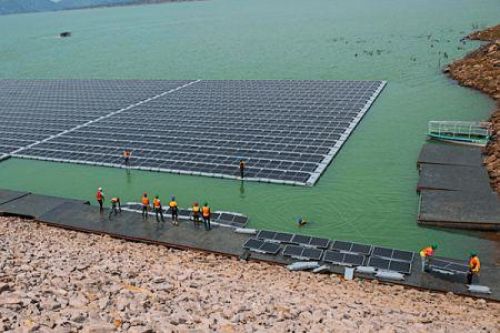The report reveals that the continent has over 100,000 square kilometers of freshwater reservoirs that could be used for floating solar farms. Exploiting just 1% of this surface area would give a 100GW potential, more than eight times the continent’s overall installed solar capacity.
Africa has the world’s largest floating solar photovoltaic generating potential, according to a report published on June 6 by the German Solar Industry Association (Bundesverband Solarwirtschaft)。
Entitled “Solarize Africa Market Report 2023”, the report reveals that the floating solar or floating photovoltaic generation process involves placing solar panels on a body of water, usually artificial and of very low environmental value, such as gravel pits, industrial lakes, or hydroelectric dams.
The most obvious benefits of this technique are the use of unused bodies of water where there are no conflicts of use, a yield 10% higher than that of land-based solar farms, favored by the cooling of the heated modules, and a significant reduction in the evaporation of water reservoirs.
According to the report, the continent’s enormous potential stems from its many freshwater reservoirs, which are ideally suited for this type of new-generation photovoltaic farm. Africa has over 100,000 square meters of artificial freshwater reservoirs that could be used for floating solar power plants. “Using only 1 % of the surface area would translate into 100 GW -around ten times the continent’s overall installed solar capacity as of end 2022- of potential capacity and 167 TWh of yearly energy output,” the report notes.
In several African countries, such as Zimbabwe, Sudan, Ethiopia, and Cameroon, the potential for solar power generation from floating farms even exceeds annual electricity demand.
11.6 GW of installed photovoltaic capacity
The German Solar Industry Association also reported that the cumulative capacity of floating parks has reached 5 GW worldwide in 2022.
Still in its infancy, the African floating solar power market has focused on experimental or commercial applications with relatively low capacity. Small floating power plants have been built in South Africa, Kenya, Burundi, and Tunisia. The largest floating solar park in Africa is due to be completed by the end of this year in Ghana. The 65 megawatts (MW) infrastructure is due to be installed on the Bui hydroelectric dam.
The report also indicates that Africa receives an average annual solar radiation of 2119 kWh/m2, and its technical solar energy potential is estimated at 7900 GW. The continent thus possesses 60% of the world’s best solar resources. But it is home to just 1% of the global solar-generating capacity
In 2022, around 1 GW of new solar capacity was installed on the continent, bringing installed photovoltaic capacity to 11.6 GW.
In terms of installed capacity, Africa’s photovoltaic champions are South Africa (5826 MW), Egypt (1704 MW), Algeria (435 MW), Morocco (318 MW), Kenya (307 MW), and Angola (297 MW)。






